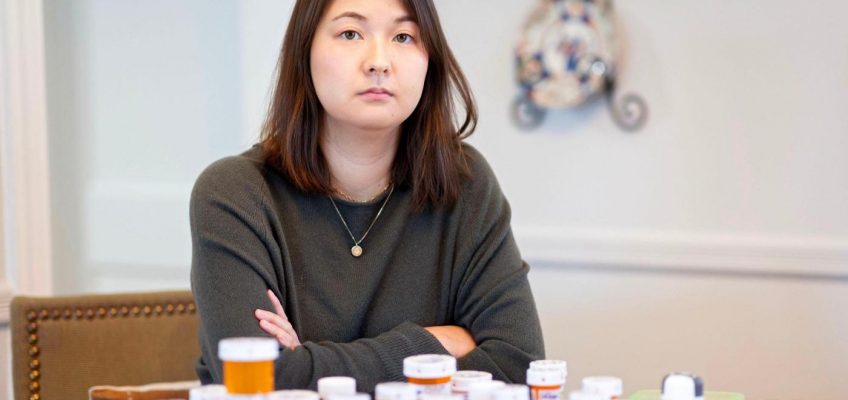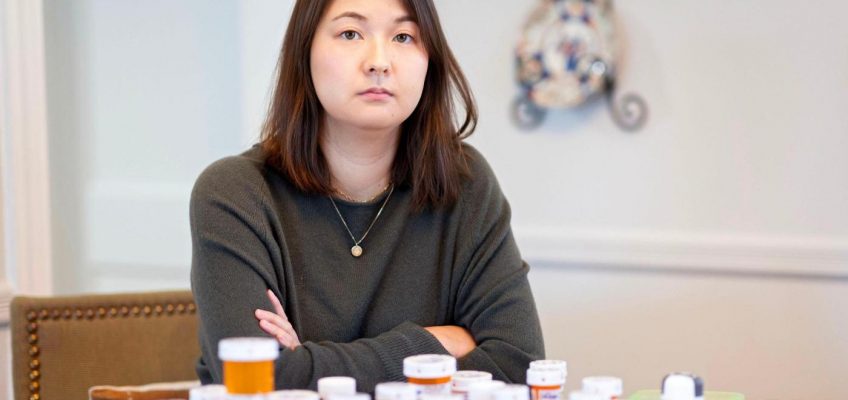By Lauren Sausser, KFF Health News
HENRICO, Va. — Sheldon Ekirch spends a lot of time on hold with her health insurance company.
Sometimes, as the minutes tick by and her frustration mounts, Ekirch, 30, opens a meditation app on her phone. It was recommended by her psychologist to help with the depression associated with a stressful and painful medical disorder.
In 2023, Ekirch was diagnosed with small fiber neuropathy, a condition that makes her limbs and muscles feel as if they’re on fire. Now she takes more than a dozen prescriptions to manage chronic pain and other symptoms, including insomnia.
“I don’t feel like I am the person I was a year and a half ago,” said Ekirch, who was on the cusp of launching her law career, before getting sick. “Like, my body isn’t my own.”
Ekirch said specialists have suggested that a series of infusions made from blood plasma called intravenous immunoglobulin — IVIG, for short — could ease, or potentially eradicate, her near-constant pain. But Ekirch’s insurance company has repeatedly denied coverage for the treatment, according to documents provided by the patient.
Patients with Ekirch’s condition don’t always respond to IVIG, but she said she deserves to try it, even though it could cost more than $100,000.
“I’m paying a lot of money for health insurance,” said Ekirch, who pays more than $600 a month in premiums. “I don’t understand why they won’t help me, why my life means so little to them.”
For patient advocates and health economists, cases like Ekirch’s illustrate why prior authorization has become such a chronic pain point for patients and doctors. For 50 years, insurers have employed prior authorization, they say, to reduce wasteful health care spending, prevent unnecessary treatment, and guard against potential harm.
The practice differs by insurance company and plan, but the rules often require patients or their doctors to request permission from the patient’s health insurance company before proceeding with a drug, treatment, or medical procedure.
The insurance industry provides little information about how often prior authorization is used. Transparency requirements established by the federal government to shed light on the use of prior authorization by private insurers haven’t been broadly enforced, said Justin Lo, a senior researcher for the Program on Patient and Consumer Protections at KFF, a health information nonprofit that includes KFF Health News.
Yet it’s widely acknowledged that prior authorization tends to disproportionately impact some of the sickest people who need the most expensive care. And despite bipartisan support to reform the system, as well as recent attempts by health insurance companies to ease the burden for patients and doctors, some tactics have met skepticism.
Some insurers’ efforts to improve prior authorization practices aren’t as helpful as they would seem, said Judson Ivy, CEO of Ensemble Health Partners, a revenue cycle management company.
“When you really dive deep,” he said, these improvements don’t seem to touch the services and procedures, such as CT scans, that get caught up in prior authorization so frequently. “When we started looking into it,” he said, “it was almost a PR stunt.”
The ‘Tipping Point’
When Arman Shahriar’s father was diagnosed with follicular lymphoma in 2023, his father’s oncologist ordered a whole-body PET scan to determine the cancer’s stage. The scan was denied by a company called EviCore by Evernorth, a Cigna subsidiary that makes prior authorization decisions.
Shahriar, an internal medicine resident, said he spent hours on the phone with his father’s insurer, arguing that the latest medical guidelines supported the scan. The imaging request was eventually approved. But his father’s scan was delayed several weeks — and multiple appointments were scheduled, then canceled during the time-consuming process — while the family feared the cancer would continue to spread.
EviCore by Evernorth spokesperson Madeline Ziomek wrote in an emailed statement that incomplete clinical information provided by physicians is a leading cause of such denials. The company is “actively developing new ways to make the submission process simpler and faster for physicians,” Ziomek said.
In the meantime, Shahriar, who often struggles to navigate prior authorization for his patients, accused the confusing system of “artificially creating problems in people’s lives” at the wrong time.
“If families with physicians are struggling through this, how do other people navigate it? And the short answer is, they can’t,” said Shahriar, who wrote about his father’s case in an essay published last year by JAMA Oncology. “We’re kind of reaching a tipping point where we’re realizing, collectively, something needs to be done.”
The fatal shooting of UnitedHealthcare CEO Brian Thompson on a New York City sidewalk in December prompted an outpouring of grief among those who knew him, but it also became a platform for public outrage about the methods insurance companies use to deny treatment.
Related Articles
Their physical therapy coverage ran out before they could walk again
Tick-borne Powassan virus creeps into Minnesota
Trump whacks tiny agency that works to make the nation’s health care safer
Tribes, long shut out from their own health data, fight for access and sovereignty
Medicaid cuts could hurt older adults who rely on home care, nursing homes
An Emerson College poll conducted in mid-December found 41% of 18- to 29-year-olds thought the actions of Thompson’s killer were at least somewhat acceptable. In a NORC survey from the University of Chicago conducted in December, two-thirds of respondents indicated that insurance company profits, and their denials for health care coverage, contributed “a great deal/moderate amount” to the killing. Instagram accounts established in support of Luigi Mangione, the 26-year-old Maryland suspect accused of murder and terrorism, have attracted thousands of followers.
“The past several weeks have further challenged us to even more intensely listen to the public narrative about our industry,” Cigna Group CEO David Cordani said during an earnings call on Jan. 30. Cigna is focused on “making prior authorizations faster and simpler,” he added.
The first Trump administration and the Biden administration put forth policies designed to improve prior authorization for some patients by mandating that insurers set up electronic systems and shortening the time companies may take to issue decisions, among other fixes. Hundreds of House Democrats and Republicans signed on to co-sponsor a bill last year that would establish new prior authorization rules for Medicare Advantage plans. In January, Republican congressman Jefferson Van Drew of New Jersey introduced a federal bill to abolish the use of prior authorization altogether.
Meanwhile, many states have passed legislation to regulate the use of prior authorization. Some laws require insurers to publish data about prior authorization denials with the intention of making a confusing system more transparent. Reform bills are under consideration by state legislatures in Hawaii, Montana, and elsewhere. A bill in Virginia approved by the governor March 18 takes effect July 1. Other states, including Texas, have established “gold card” programs that ease prior authorization requirements for some physicians by allowing doctors with a track record of approvals to bypass the rules.
No one from AHIP, an insurance industry lobbying group formerly known as America’s Health Insurance Plans, was available to be interviewed on the record about proposed prior authorization legislation for this article.
But changes wouldn’t guarantee that the most vulnerable patients would be spared from future insurance denials or the complex appeals process set up by insurers. Some doctors and advocates for patients are skeptical that prior authorization can be fixed as long as insurers are accountable to shareholders.
Kindyl Boyer, director of advocacy for the nonprofit Infusion Access Foundation, remains hopeful the system can be improved but likened some efforts to playing “Whac-A-Mole.” Ultimately, insurance companies are “going to find a different way to make more money,” she said.
‘Unified Anger’
In the weeks following Thompson’s killing, UnitedHealthcare was trying to refute an onslaught of what it called “highly inaccurate and grossly misleading information” about its practices when another incident landed the company back in the spotlight.
On Jan. 7, Elisabeth Potter, a breast reconstruction surgeon in Austin, Texas, posted a video on social media criticizing the company for questioning whether one of her patients who had been diagnosed with breast cancer and was undergoing surgery that day needed to be admitted as an inpatient.
The video amassed millions of views.
In the days following her post, UnitedHealthcare hired a high-profile law firm to demand a correction and public apology from Potter. In an interview with KFF Health News, Potter would not discuss details about the dispute, but she stood by what she said in her original video.
“I told the truth,” Potter said.
The facts of the incident remain in dispute. But the level of attention it received online illustrates how frustrated and vocal many people have become about insurance company tactics since Thompson’s killing, said Matthew Zachary, a former cancer patient and the host of “Out of Patients,” a podcast that aims to amplify the experiences of patients.
For years, doctors and patients have taken to social media to shame health insurers into approving treatment. But in recent months, Zachary said, “horror stories” about prior authorization shared widely online have created “unified anger.”
“Most people thought they were alone in the victimization,” Zachary said. “Now they know they’re not.”
Data published in January by KFF found that prior authorization is particularly burdensome for patients covered by Medicare Advantage plans. In 2023, virtually all Medicare Advantage enrollees were covered by plans that required prior authorization, while people enrolled in traditional Medicare were much less likely to encounter it, said Jeannie Fuglesten Biniek, an associate director at KFF’s Program on Medicare Policy. Furthermore, she said, Medicare Advantage enrollees were more likely to face prior authorization for higher-cost services, including inpatient hospital stays, skilled nursing facility stays, and chemotherapy.
But Neil Parikh, national chief medical officer for medical management at UnitedHealthcare, explained prior authorization rules apply to fewer than 2% of the claims the company pays. He added that “99% of the time” UnitedHealthcare members don’t need prior authorization or requests are approved “very, very quickly.”
Recently, he said, a team at UnitedHealthcare was reviewing a prior authorization request for an orthopedic procedure when they discovered the surgeon planned to operate on the wrong side of the patient’s body. UnitedHealthcare caught the mistake in time, he recounted.
“This is a real-life example of why prior authorization can really help,” Parikh said.
Even so, he said, UnitedHealthcare aims to make the process less burdensome by removing prior authorization requirements for some services, rendering instant decisions for certain requests, and establishing a national gold card program, among other refinements. Cigna also announced changes designed to improve prior authorization in the months since Thompson’s killing.
“Brian was an incredible friend and colleague to many, many of us, and we are deeply saddened by his passing,” Parikh said. “It’s truly a sad occasion.”
The Final Denial
During the summer of 2023, Ekirch was working full time and preparing to take the bar exam when she noticed numbness and tingling in her arms and legs. Eventually, she started experiencing a burning sensation throughout her body.
That fall, a Richmond-area neurologist said her symptoms were consistent with small fiber neuropathy, and, in early 2024, a rheumatologist recommended IVIG to ease her pain. Since then, other specialists, including neurologists at the University of Virginia and Virginia Commonwealth University, have said she may benefit from the same treatment.
There’s no guarantee it will work. A randomized controlled trial published in 2021 found pain levels in patients who received IVIG weren’t significantly different from the placebo group, while an older study found patients responded “remarkably well.”
“It’s hard because I look at my peers from law school and high school — they’re having families, excelling in their career, living their life. And most days I am just struggling, just to get out of bed,” said Ekirch, frustrated that Anthem continues to deny her claim.
In a prepared statement, Kersha Cartwright, a spokesperson for Anthem’s parent company, Elevance Health, said Ekirch’s request for IVIG treatment was denied “because it did not meet the established medical criteria for effectiveness in treating small fiber neuropathy.”
On Feb. 17, her treatment was denied by Anthem for the final time. Ekirch said her patient advocate, a nurse who works for Anthem, suggested she reach out to the drug manufacturer about patient charity programs.
“This is absolutely crazy,” Ekirch said. “This is someone from Anthem telling me to plead with a pharmacy company to give me this drug when Anthem should be covering it.”
Her only hope now lies with the Virginia State Corporation Commission Bureau of Insurance, a state agency that resolves prior authorization disputes between patients and health insurance companies. She found out through a Facebook group for patients with small fiber neuropathy that the Bureau of Insurance has overturned an IVIG denial before. In late March, Ekirch was anxiously waiting to hear the agency’s decision about her case.
“I don’t want to get my hopes up too much, though,” she said. “I feel like this entire process, I’ve been let down by it.”
©2025 KFF Health News. Distributed by Tribune Content Agency, LLC.




